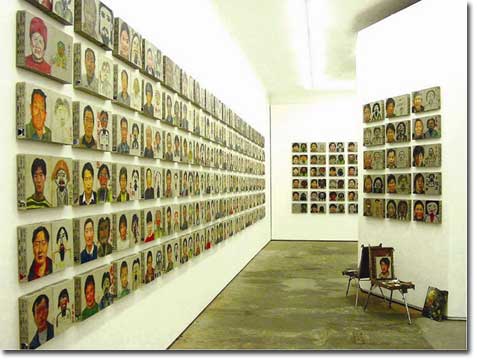Venice Biennale,
Sep 01, 2004 - Dec 01, 2004
Venice, Italy
26th International Biennial of Sí¢o Paulo, 2004
by Virginia Gil Araujo
Painting Salon
The emphasis on painting brings nothing new to the presentation, even in spite of praise-worthy portraits by Chinese artist Chen Shaofeng, "O Povo Sem Voz" (The Voiceless People). In this vast series, the artist traverses the aesthetic language of a more sociologic object. The portraits shown are those of the inhabitants of certain villages from the Hubei province, where Chen has painted close to 250 portraits. The sitters in the portraits weren't passive subjects, that is to say, the model enjoyed a discussion with the artist, who at the same time also acted as a model for the sitter, thus producing a reciprocal action.
The search for an intense dialogue with the public can also be observed in the project of Thai artist Navin Rawanchaikul. "Please Donate Your Ideas for a Biennial Artist" seeks to create a group show out of the public's suggestions for the artist and the biennial. The program, however, was unable to be completed due to a lack of material resources for the participants. Faced with a lack of paper, the public asks itself during the biennial's final days how important it really is to have an "open" biennial, which received the rather decent sum of 18 million reales.
Photography and Video Installation
What we can hope for from such an extensive biennial are some great black and white photographs by German artist Vera Lutter. In "Mind Set, Studio III", the shadowy lines of light suspend time in a mysterious and unknown space. In addition to Lutter, pinhole photography, which was also an attraction at the 25th biennial in the distinguished work of Michael Wesely, stands out in the work Dark Caravan, begun over 15 years ago by the national representatives of Belgium. Christine Felten and Véronique Massinger transformed a van into a dark chamber. The images captured in Belgium, France and even some in Brazil, contain a poetic sentiment imbued by photography's ability to move between the visible and invisible, and show strangely illuminated sites in the cities they traveled through.
Highlights in the works done in digital film include the those of Jonas Dahlberg in the series "Invisible Cities", Melik Ohanian in the seven paintings "Seven Minutes Before", Julian Rosefeldt in "Asylum" and in the work by the couple Aí¯nouz and Gomes, "Se tudo fosse sempre assim" (If everything were always thus). But alas, Chantal Akerman and Sylvie Blocher were absent in contributing their insight to the discussion on video installations as activist practices.
Photography and video weren't the only things that stood out. Italian artist Máximo Bortoline, sensitive to the exterior view provided by the pavilion, created a space reserved for nature, which served as the leit motif in his work "One Can Hier". The poetic dialog with Ibirapuera Park begins with a quote from César Calvo's short poetic essay "Las tres mitades de Ino Moxo" (The three halves of Ino Moxo), about the sounds and virtues of Amazonian plants. The words engraved upon the panes of glass of the Niemeyer building are made of space, only visible against the green of the trees outside. In the catalog art critic Jacopo Criveli Visconti writes: "Like the plants he speaks of, the very text resonates and vibrates until it becomes nature itself, crowning, perhaps, the secret wish of the author (or of its authors)".
|









